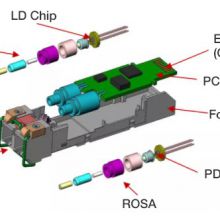
1. Introduction of optical moduleAs an important part of fiber optic communication, optical module is an optoelectronic device that realizes the function of photoelectric conversion and electro-optical conversion. To be precise, optical module is the general name of several types of modules, including optical transmitting module transmitter, optical receiving module receiver, optical transceiver module transmitter and optical forwarding module transmitter. Generally, the optical module we call generally refers to the integrated optical transceiver module, namely, optical transceiver. ① Working principle of optical transceiver Optical transceiver works in the physical layer of OSI model and is one of the core devices in optical fiber communication system. It is mainly composed of optoelectronic devices (optical transmitter, optical receiver), functional circuit and optical (Electrical) interface. Components of an optical transceiver Basic principle: the transmitting interface inputs an electrical signal with a certain code rate. After being processed by the internal driving chip, the driving semiconductor laser (LD) or light emitting diode (LED) emits a modulated optical signal with a corresponding rate. After being transmitted through the optical fiber, the receiving interface converts the optical signal from the optical detection diode into an electrical signal, After passing through the preamplifier, the electrical signal of the corresponding code rate is output. ② Key parameters of optical transceiver The key technical indicators of the optical transceiver mainly include: transmitting optical power, receiving optical power, overload optical power, maximum receiving sensitivity and extinction ratio. A. Transmitting optical power: refers to the optical power output by the light source at the transmitting end of the optical module under normal working conditions, which can be understood as the intensity of light, and the unit is w or MW or DBM. Where w or MW is the linear unit and DBM is the logarithmic unit. In communication, we usually use DBM to represent optical power, and the optical power of 0dbm corresponds to 1MW.B. Receiving optical power: refers to the average optical power range that can be received by the receiving end component under the condition of a certain bit error rate (BER = 10-12). The upper limit value is the overload optical power, and the lower limit value is the maximum value of reception sensitivity.C. Overload optical power: also known as saturated optical power, it refers to the maximum input average optical power that can be received by the receiver component when a certain bit error rate (BER = 10-12) is maintained at a certain transmission rate (unit: DBM). It should be noted that the photocurrent saturation of the photodetector will occur under strong light irradiation. Therefore, strong light irradiation should be avoided as far as possible to prevent exceeding the saturated light power.D. Receiving sensitivity: refers to the minimum average input optical power that can be received by the receiving end component when a certain bit error rate (BER = 10-12) is maintained at a certain transmission rate (unit: DBM). Generally, the higher the rate, the worse the reception sensitivity, that is, the greater the minimum received optical power, and the higher the requirements for the receiving devices of the optical transceiver.E. Extinction ratio (EXT): it is one of the important parameters used to measure the quality of optical modules. It refers to the ratio of the optical power P1 (when the laser emits all "1" codes) to P0 (when the laser emits all "0" codes) under the condition of full modulation, and the unit is dB. It is not that the greater the extinction ratio, the better the quality of the optical module, but that the optical module with an extinction ratio can meet the IEEE 802.3 standard is the better. ③ Example of optical transceiver information on the switch: Cisco switch interface optical transceiver information: Huawei switch interface optical transceiver information:2. Classification and packaging(form-factor) of optical transceivers ① Transmission rate: The current common types of optical modules are as follows:400GE optical module200GE optical module100GE optical module40GE optical module25GE Optical Module10GE Optical ModuleGE Optical ModuleFE Optical Module ② Form-factors: The higher the transmission rate, the more complex the structure, resulting in form-factors. For example, SFP/eSFP, SFP+, SFP28, QSFP+, CXP, CFP, QSFP28, etc. l SFP (Small Form-factor Pluggable) optical module: small pluggable SFP module supports LC fiber connector.l SFP + (Small Form-factor Pluggable plus) optical module: refers to the SFP module with increased rate. Because of the increased rate, it is sensitive to EMI and smaller than the SFP module.l XFP (10GB Small Form-factor Pluggable) optical module: "X" is the abbreviation of Roman numeral 10. All XFP modules are 10GE optical modules. The XFP optical module supports LC optical fiber connectors. Compared with SFP + optical module, XFP optical module is wider and longer in size.l SFP28 (Small Form-factor Pluggable 28) optical module: the interface package size is the same as that of SFP +, and supports 25G SFP28 optical module and 10G SFP + optical module.l QSFP+ (Quad Small Form-factor Pluggable) optical module: four channel small hot pluggable optical module. QSFP + optical module supports MPO optical fiber connector, which is larger than SFP + optical module. Fiber Mall 40G QSFP+ Optical Transceivers l CXP (120 GB/s Extended Capability Form-factor Pluggable) optical module: it is a hot-pluggable high-density parallel optical module standard. It provides 12 channels in the transmit and receive (TX / Rx) directions. It is only applicable to short-range multimode links.l CFP (CENTUM Form-factor pluggable) optical module: the size is defined as 144.75mm × 82mm × 13.6mm, which is a new optical module standard with high speed, hot-pluggable and supporting two applications of data communication and telecommunication transmission.l QSFP28 (Quad Small Form-factor Pluggable 28) optical module: the interface package size is the same as QSFP+, and supports 100G QSFP28 optical module and 40G QSFP+ optical module. ③ Single-mode or muti-mode? The optical fiber is divided into single-mode optical fiber and multi-mode optical fiber. The single-mode optical module is used together with the single-mode optical fiber. The single-mode optical fiber has wide transmission frequency bandwidth and large transmission capacity, which is suitable for long-distance transmission; The multi-mode optical module is used together with multi-mode optical fiber, and multi-mode optical fiber has mode dispersion defect, and its transmission performance is worse than that of single-mode optical fiber, but the cost is low. Therefore, it is suitable for small capacity and short-distance transmission. ④ Wavelength The central wavelength refers to the waveband used for optical signal transmission. At present, there are three kinds of common central wavelengths: 850nm, 1310nm and 1550nm.850nm: mostly used for short distance transmission (≤ 2km)1310nm and 1550nm: mostly used for medium and long distance transmission (>2km) ⑤ Transmission distance According to the different transmission distance of optical module, it can be divided into:Short distance optical module: ≤ 2kmMedium distance optical module, 10 ~ 20kmLong distance optical module: ≥30km.The transmission distance of optical modules is limited mainly because of the loss and dispersion of optical signals during fiber transmission. ⑥ Photoelectric module The photoelectric module is usually called electric port module or RJ45 SFP module. Unlike the optical module, the electric port module does not carry out photoelectric conversion. Through the switching of the electric module, the two optical interfaces can be connected with a network cable.RJ45 Copper SFP Module 3. Development and evolution of optical transceiversIn the current physical architecture network of mainstream data centers, Spine-Leaf (Clos network architecture) architecture is commonly followed. Usually 10GE interface is used as the access side server docking, and 40GE interface is commonly used for the uplink on the Leaf side. In large data centers, it has been common to use 25G as the mainstream access and 100G uplink. In scenarios requiring high computation and high bandwidth, GPU servers have been using 100GE and even 200GE access. Data center switch interconnects are evolving to large-scale 400GE interconnects.The development of Ethernet has undergone rapid changes from 1Mbit/s, 10Mbit/s, 100Mbit/s (FE), 1Gbit/s (GE), 10Gbit/s (10GE) to 40Gbit/s (40GE), 100Gbit\s (100GE), and with the rapid development of big data, smart cities, mobile Internet, cloud computing, network traffic has shown exponential growth. The thirst for continuous growth of bandwidth will require higher bandwidth rates, and optical modules will develop rapidly.
Fiber Optic Transceivers Optical Module Fiber Optic 2986 81 07/29/21RECENT POSTS
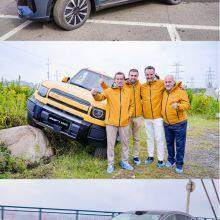
WUHU, China, Oct. 19, 2025 /PRNewswire/ -- From October 17 to 21, under the theme "Co-Create • Co-Define," the 2025 Chery International User Summit gathered 1,200 guests from over 100 countries and regions in Wuhu. The event offered an immersive look at Chery's full-spectrum ecosystem — powered by new energy and intelligent technology, covering every mobility scenario. From family sedans to off-road SUVs, from racetrack tests to outdoor challenges, Chery engaged participants through test drives, immersive experiences, and user research — embodying its co-creation philosophy and showcasing how inclusive innovation is transforming mobility worldwide. All Chery Brands Unite: Personalized Experiences Tailored for Every Guest All Chery Brands Unite: Personalized Experiences Tailored for Every Guest The test drive brought together five of Chery International's core brands — CHERY, EXEED, OMODA & JAECOO, iCAUR, LEPAS, and LUXEED — showcasing over ten flagship models across a full spectrum of mobility scenarios, from family to off-road, from youthful to premium. Combining static analysis, dynamic testing, and tech immersion, the event offered customized experiences tailored to diverse user profiles worldwide. As the trusted choice for millions of families, CHERY demonstrated its enduring strength through the TIGGO series (TIGGO 4/7/8/9) — offering safety, space, and comfort that redefine family mobility. The KP11 pickup, balancing rugged off-road capability with everyday practicality, extended the boundaries of family adventure with reliability and joy. Through an immersive "Performance Journey" and static showcases, EXEED presented its latest achievements in electrification, hybrid power, intelligence, and design—offering guests a firsthand experience of multiple industry "firsts" and "onlys." In the BEV segment, as a premium global NEV brand, EXLANTIX demonstrated its electric lineup capable of 0-100 km/h acceleration in just around 3 seconds, delivering supercar-level performance and a best-in-class turning radius of 5.65 meters. For hybrid technology, the REEV model is equipped with dual front and rear electric motors producing a combined output of 345 kW. Its electric-drive system ensures instant acceleration and a refined, EV-like driving experience that sets new benchmarks in the segment. Targeting the next generation of drivers, OMODA & JAECOO hosted Intelligent Co-Creation Camp and Hybrid Co-Creation Camp sessions featuring O7 and J8. Through RPA/APA auto parking, acceleration, and elk tests, participants experienced the synergy of smart control and hybrid power — catering to diverse driving preferences. All Chery Brands Unite: Personalized Experiences Tailored for Every Guest Positioned as a timeless classic, iCAUR showcased its 03T REEV, 03T BEV, and V23 BEV under the theme "Golden Range, All-Terrain Conquest." At the off-road testing site, users experienced the models' remarkable endurance and adaptability, enjoying the thrill of mastering challenging terrains. The LEPAS brand, known for its refined driving aesthetics, introduced a playful "Unbox Elegance" test drive featuring L4, L6, and L8 models. Through activities like linear acceleration, outdoor power supply demos, and a "52 Storage Spots" treasure hunt, participants brewed coffee and grilled snacks on-site, experiencing firsthand the blend of sophistication and practicality in elegant mobility. LUXEED, Chery's flagship intelligent brand, presented advanced innovations in the Smart Drive Zone. The R7 demonstrated VPD (Valet Parking Driver) and wireless charging, offering seamless cross-zone summoning and autonomous parking — giving participants a glimpse into the effortless convenience of future electric mobility and reinforcing Chery's leadership in intelligent technology. All Chery Brands Unite: Personalized Experiences Tailored for Every Guest Comprehensive Research: Turning User Voices into Product Evolution The test drive program featured a multi-dimensional research matrix, covering everything from sensory feedback to strategic insights. A dynamic driving survey captured real-time evaluations of acceleration, braking, handling, and cabin quietness. Meanwhile, a static design study—powered by 150 iPads—collected detailed data on user preferences for styling, interiors, and features. Additionally, in-depth HEV interviews explored market-specific expectations and challenges, helping outline a clear 'demand map' for Chery's hybrid product strategy worldwide. All surveys were customized by brand, model, and market to ensure precision and actionable insights. This systematic research approach serves not just as a feedback channel, but as a strategic bridge aligning technology evolution with user needs. By transforming real-world user experiences into measurable data, Chery ensures that user feedback becomes a true driver of continuous innovation, continuously refining product performance and informing future technology and model planning. This full-spectrum test drive — spanning all Chery brands and mobility scenarios — was more than a showcase of technical strength; it was a genuine co-creation dialogue with users worldwide. Through an integrated experience of driving, listening, and co-defining, the test drive session of the 2025 Chery International User Summit brought the "CO-CREATE • CO-DEFINE" philosophy to life — transforming vision into action, and ideas into reality.
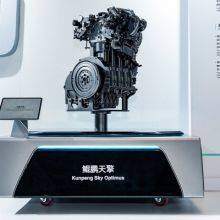
WUHU, China, Oct. 19, 2025 /PRNewswire/ -- As the global new energy vehicle (NEV) industry accelerates toward electrification, hybrid technology has emerged as a crucial pathway, offering practical value and bridging the transition to full electrification. With its deep technical expertise and global footprint, Chery Group has earned widespread international recognition — achieving cumulatively 587,545 unit NEV sales volume by the end of September. This growing user base provides a wealth of real-world insight that fuels Chery's technological innovation. On October 18, 2025, Chery hosted the International Technology Night, an event that showcased its landmark 48% thermal efficiency breakthrough and reaffirmed its leadership in innovation and forward-looking technology in the new energy era. Breaking Barriers: Global R&D Powers Technological Breakthroughs Supported by its eight global R&D centers across Europe, North America, and Asia, Chery's innovation ecosystem enables it to deeply understand diverse markets and translate those insights into precise technological solutions. The company's latest-generation hybrid engine, achieving an unprecedented 48% thermal efficiency, stands as a powerful testament to this collaborative, global R&D strength. This milestone was made possible through the integration of global engineering expertise — achieving a 26:1 ultra-high expansion ratio, maintaining optimal air-fuel balance for complete combustion, and utilizing a 35% EGR rate to effectively reduce energy loss.Together, these advances have pushed gasoline energy utilization to its current engineering limits, offering an ideal balance of performance and efficiency for drivers worldwide. Perfectly paired with a new-generation hybrid transmission delivering 93% efficiency, the powertrain forms the core of Chery's "Super Hybrid" technology. From the fuel-efficient 1.5L series to the high-performance 2.0TGDI 280kW configuration, and the vector dual-motor system designed for off-road scenarios, Chery delivers diversified hybrid solutions precisely tailored to meet the needs of different global markets. Kunpeng Sky Optimus Advancing Intelligence: Data-Driven Mobility for the Future In the realm of intelligence, Chery has established a comprehensive smart R&D system, integrating teams focused on intelligent cockpits, autonomous driving, and electronic architecture into a closed-loop ecosystem spanning hardware, algorithms, data, software, ecosystems, and scenarios. Powered by 24 billion kilometers of global validation data and its proprietary "Digital Twin Universe" simulation platform, Chery conducts 20 million kilometers of model learning and 1 million kilometers of virtual verification every day, ensuring rapid and reliable technological evolution. Chery is also the first automaker to obtain dual EU certifications for vehicle cybersecurity and software update management and has achieved the ASIL D highest-level functional safety certification. Its overseas users have already accumulated over 4.5 billion kilometers of intelligent assisted driving, demonstrating both robust reliability and worldwide adaptability. The company's Integrated Intelligent Driving Control Platform analyzes regional driving environments and habits through a global perception network, enabling intelligent coordination among powertrain, chassis, and body systems. This innovation enhances safety, comfort, and efficiency, delivering a smarter mobility experience for global users. Chery Super Hybrid Platform (CSH) Global Collaboration: Building a New R&D Ecosystem During Technology Night, Chery officially launched its Global Partner Co-Creation Initiative, joining hands with key partners across the global supply chain to establish a new collaborative innovation model. This marks Chery's strategic transformation from a "technology exporter" to a "technology co-creator." This open and synergistic model integrates local market needs directly into the R&D process, accelerating the evolution of hybrid technologies from single-solution approaches toward diversified and customized applications. Through initiatives such as forming localized R&D teams and participating in regional standard-setting, Chery continues to strengthen its roots in global markets — laying the foundation for sustainable global innovation. Driving the Future of New Energy: Technology as the Catalyst for Industry Transformation From its record-breaking 48% thermal efficiency engine to cutting-edge intelligent systems, and the creation of a global technology alliance, Chery has charted a clear pathway for the development of next-generation new energy technologies. In today's fast-evolving NEV landscape, hybrid power stands as a vital technology for achieving carbon peaking and carbon neutrality goals, and its market potential continues to expand rapidly. Industry forecasts suggest that by 2030, hybrid technologies will occupy a significantly larger share of the global NEV market, becoming a key driver of growth. Leveraging its profound technological foundation and consistent investment in innovation, Chery Group is establishing a distinctive edge in this field. As electrification and intelligentization converge further, Chery will continue to advance hybrid technologies toward greater efficiency, intelligence, and sustainability. Guided by its global philosophy of "In somewhere, For somewhere," Chery Group is driving forward through technological innovation and open collaboration, working hand in hand with global partners to accelerate the automotive industry's transition toward a greener, smarter future. Chery's breakthroughs not only highlight the company's engineering strength but also contribute meaningfully to the sustainable evolution of the global automotive industry.
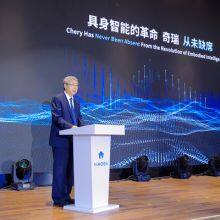
In today's rapidly evolving global industrial landscape, technological innovation has taken on a new mission. Its value now extends beyond individual product breakthroughs — toward building systemic ecosystems that integrate technology with users, scenarios, and society at large. WUHU, China, Oct. 19, 2025 /PRNewswire/ -- The 2025 AiMOGA Global Business Conference, a core event of the 2025 Chery International User Summit, was held in Wuhu. Incubated by Chery Group, AiMOGA Robotics unveiled its new global brand strategy, marking a milestone in Chery's vision for the "Automotive + Robot" era. This launch was not only a showcase of intelligent innovation but also a statement of Chery's forward-looking thinking on the future mobility ecosystem. By developing a dual-driven system that integrates automotive engineering and robotics, Chery is building an open, collaborative, and intelligent ecosystem — providing a systematic innovation model for global industrial transformation. The 2025 AiMOGA Global Business Conference Strategic Elevation: From Automotive Manufacturing to New Growth Engines As industries worldwide seek greater resilience and synergy, building a collaborative innovation ecosystem has become the central theme of this year's summit. The release of AiMOGA Robotics' new brand strategy represents Chery's key response to this challenge. At the brand strategy launch, Zhang Guibing, General Manager of AiMOGA Robotics, outlined the company's development blueprint — a deep integration of intelligent vehicle and robotic technologies. AiMOGA will gradually roll out a family of humanoid and quadruped robots across diverse application fields including marketing, education, companionship, industrial, and home services, with a vision to become a world-leading and trusted human AI assistant. To realize this vision, AiMOGA has set a clear five-year plan: by 2030, global sales of quadruped robots are expected to exceed 90,000 units, and humanoid robots to surpass 40,000 units, striving to become one of the world's top-tier robotics enterprises. This ambition reflects not only AiMOGA's confidence as an independent business unit, but also Chery Group's strategic determination to make robotics a new growth engine for the future. Family of robots and robot pets Technological Synergy: Hard-Core Innovation Drives Capability Upgrades The technology release segment of the event served as a window into Chery Group's engineering excellence. According to Xia Peng, Executive Vice General Manager of AiMOGA Robotics, after three years of intensive R&D, AiMOGA has successfully achieved a leap from L2 (collaborative-level) to L3 (assistance-level) capability — a key milestone in the journey toward higher-level intelligence. The realization of L3 capability provides the technical foundation for AiMOGA's positioning as a "human assistant." Behind this breakthrough lies Chery Group's strong system-level empowerment: The high-torque-density joints in AiMOGA's "powerful limbs" draw on Chery's expertise in advanced EV joint technologies, including motors and reducers. The cloud platform MoLink, acting as the robot's "intelligent brain," shares its data-processing architecture with Chery's connected-vehicle systems. The multimodal perception system and self-developed vision-language model MoNet benefit from Chery's long-term investment in intelligent driving perception. Together, these elements embody Chery's philosophy of technological synergy and ecosystem sharing, turning automotive expertise into a sustainable innovation engine for robotics. AiMOGA VLM: MoNet Ecosystem for Growth: Global Network Accelerates AiMOGA's Expansion As a world-class green mobility technology enterprise and China's No.1 passenger car exporter for 22 consecutive years, Chery Group now serves over 17.7 million users across 120+ countries and regions, supported by more than 11,000 service outlets worldwide — providing AiMOGA Robotics with a strong foundation for global expansion. AiMOGA has already become the world's first humanoid robot to complete hardware and software EU certifications, and has entered over 30 countries, including Malaysia, Indonesia, the UAE, and South Africa. This achievement builds on Chery's extensive experience in international market access, channel development, and brand trust, accelerating AiMOGA's global rollout. Looking ahead, AiMOGA will continue leveraging Chery's worldwide network to establish a "global coverage, real-time response, and full-dimensional support" service system, co-creating a new global robotics ecosystem together with partners around the world. Conclusion From the banks of the Yangtze River to the global stage, the 2025 Chery International User Summit not only witnessed AiMOGA Robotics' strategic release, but also showcased Chery Group's transformation from an automotive manufacturer to a technology-driven ecosystem enterprise. Under the theme "Co-Create • Co-Define," Chery is using AiMOGA Robotics as a platform to merge automotive technology, global operations, and embodied intelligence, opening a new chapter from product innovation to ecosystem integration. Together with users and partners worldwide, Chery will continue to shape a technology-driven, ecosystem-coexistent, and value-sharing future, fostering global collaboration that transcends borders and industries.
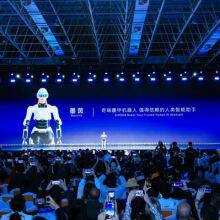
WUHU, China, Oct. 19, 2025 /PRNewswire/ -- At the 2025 Chery Global Innovation Conference, an extraordinary "guest" took the stage — Mornine, the intelligent robot from AiMOGA Robotics. Opening in seven languages, she completed a fully autonomous presentation, marking the moment when "Automotive + Robot" collaboration officially moved from concept to reality. Center Stage: Autonomous Presentation Illustrates Ecosystem Advancement Following Dr. Gao Xinhua's keynote, Mornine appeared on stage and independently completed a full capability demonstration in just three minutes. She reviewed AiMOGA's journey from early concept to real-world deployment across more than 30 countries. As Dr. Gao emphasized, this appearance signifies Chery's technological expansion from "wheels" to a "three-dimensional ecosystem," where intelligent robots represent a natural extension of Chery's innovation strategy. Technological Foundation: Robotics Grown from Automotive DNA The technology system of AiMOGA Robotics is rooted in Chery's vehicle-engineering platform. From multilingual interaction (11 languages) to ±5 cm high-precision autonomous navigation and dynamic obstacle avoidance, Mornine inherits Chery's expertise in intelligent cockpits and driver-assistance engineering. These reusable and scenario-driven capabilities enable an end-to-end intelligent service process, allowing Mornine to perform dealership reception and extend into museums, malls, and public service scenarios as a trusted human AI assistant. Scenario Application: From Demonstration to Real-World Practice At the venue, Mornine completed a fully autonomous car-purchasing reception process, covering greeting, vehicle explanation, door-opening, and car-machine collaboration. Interactive zones showcased her vision-tactile dexterous hand and multi-expression interaction system, enabling delicate object manipulation and real-time emotional expressions. These advances mark a breakthrough in multimodal perception and human-like interaction, setting new standards for intelligent service robots. Conclusion The 2025 Chery Global Innovation Conference showcased AiMOGA Robotics' achievements in language interaction, navigation control, and multimodal execution, while verifying its real-world applications in 4S dealerships. As a key practice of Chery's "Automotive + Robot" human-machine collaboration strategy, Mornine continues to demonstrate perceptive, executable, and deployable service capabilities—bringing embodied intelligence from the lab into daily life. Born from the automotive industry and advancing toward real-world scenarios, AiMOGA Robotics is paving a new evolutionary path for the industry—one that connects vehicle engineering with intelligent service innovation.


